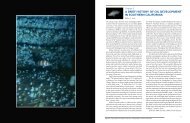checklist (pdf) - The Love Lab - University of California, Santa Barbara
checklist (pdf) - The Love Lab - University of California, Santa Barbara
checklist (pdf) - The Love Lab - University of California, Santa Barbara
Create successful ePaper yourself
Turn your PDF publications into a flip-book with our unique Google optimized e-Paper software.
Eumicrotremus asperrimus (Tanaka, 1912). Siberian Lumpsucker. To 13.5 cm (5.3 in) TL (Mecklenburg et<br />
al. 2002). Japan and Okhotsk seas and Pacific Ocean <strong>of</strong>f Hokkaido to western Bering Sea at Natalia Bay,<br />
Koryak coast (61°10'N; Andriashev 1937, Lindberg and Legeza 1955) to Pacific Ocean south <strong>of</strong> Unimak<br />
Island, Aleutian Islands (Mecklenburg and Sheiko 2003). At depths <strong>of</strong> 30–900 m (99–2,970 ft); juveniles<br />
usually shallower than 100 m (330 ft; Mecklenburg et al. 2002). Until recently went by the name <strong>of</strong><br />
Eumicrotremus birulai Popov, 1928, which is now recognized as a junior synonym (Mecklenburg and<br />
Sheiko 2003).<br />
Eumicrotremus barbatus (Lindberg & Legeza, 1955). Papillose Lumpsucker. To 7.0 cm (2.8 in) TL (UW<br />
49408). Sea <strong>of</strong> Okhotsk <strong>of</strong>f Hokkaido, Japan (Kido 1984); Pacific Ocean <strong>of</strong>f Paramushir Island, Kuril<br />
Islands (Lindberg and Legeza 1955); and Aleutian Islands from Near Islands (UW 49414) to south <strong>of</strong><br />
Unimak Island (UW 42943; Mecklenburg and Sheiko 2003). “At the shore” (Ueno 1970) to depth <strong>of</strong><br />
210 m (693 ft; Kido 1984).<br />
Eumicrotremus derjugini Popov, 1926. Leatherfin Lumpsucker. To 12.7 cm (5 in) TL (Mecklenburg et<br />
al. 2002). Isolated population in northern Sea <strong>of</strong> Okhotsk; most Arctic seas, including Beaufort Sea<br />
(Mecklenburg et al. 2002) and East Siberian Sea, but not Chukchi Sea (Mecklenburg and Sheiko 2003).<br />
Not confirmed from <strong>Lab</strong>rador; the specimen (USNM 105009) reported from there by authors (e.g.,<br />
Scott and Scott 1988) is Eumicrotremus eggvinii (not a West Coast species; Mecklenburg and Sheiko<br />
2003). At depths <strong>of</strong> 50–930 m (165–3,069 ft) (min.: Andriashev 1954; max.: Jensen 1944).<br />
Eumicrotremus gyrinops (Garman, 1892). Alaskan Lumpsucker. To 3.75 cm (1.5 in) SL. Southeastern<br />
Bering Sea <strong>of</strong>f St. Paul Island, Pribil<strong>of</strong> Islands. Shallow water. All in Mecklenburg et al. (2002). Known<br />
with certainty only from the holotype; possibly the senior synonym <strong>of</strong> E. phrynoides (Mecklenburg and<br />
Sheiko 2003).<br />
Eumicrotremus orbis (Günther, 1861). Pacific Spiny Lumpsucker. To 12.7 cm (5 in) TL (Mecklenburg et al.<br />
2002). Pacific coast <strong>of</strong> Hokkaido, Japan to Bering Sea and to Puget Sound, Washington (Mecklenburg<br />
and Sheiko 2003). Shallow water, at 2 m (6.6 ft) or less (Miller et al. 1980), to 359 m (1,178 ft; UW 46668);<br />
reported as deep as 575 m (1,898 ft; Allen and Smith 1988). Many specimens previously recorded in the<br />
literature as E. orbis were misidentified, including those from Okhotsk Sea, Kuril Islands, Pacific Ocean<br />
<strong>of</strong>f southeastern Kamchatka, Russia; and northeastern Bering Sea, Alaska (Mecklenburg and Sheiko<br />
2003).<br />
Eumicrotremus phrynoides Gilbert & Burke, 1912. Toad Lumpsucker. To 7.4 cm (2.9 in) TL (Mecklenburg et<br />
al. 2002). Near Strait (52°59'N, 172°19'E; UW 49601), Aleutian Islands and southeastern Bering Sea near<br />
Pribil<strong>of</strong> Islands (USNM 53807; Mecklenburg and Sheiko 2003) to northern Gulf <strong>of</strong> Alaska (59°54'N,<br />
148°02'W; Mecklenburg et al. 2002). At depths <strong>of</strong> 69–235 m (228–771 ft) (min.: Mecklenburg et al.<br />
2002; max.: UW 111314). Possibly a junior synonym <strong>of</strong> E. gyrinops (Mecklenburg and Sheiko 2003).<br />
Cyclopteropsis inarmatus Mednikov & Prokhorov, 1956, may be a junior synonym, and if this is the<br />
case the species is known also from western Bering Sea (Glubokaya Bight, Koryak coast, 60°50'N; B. A.<br />
Sheiko and C. W. M., unpubl. data).<br />
Eumicrotremus soldatovi Popov, 1930. Soldatov’s Lumpsucker. To about 26 cm (10.2 in) TL (Mecklenburg<br />
et al. 2002). Northern Okhotsk Sea and North Pacific Ocean <strong>of</strong>f southeastern Kamchatka (Mecklenburg<br />
and Sheiko 2003); one record from Bering Sea, Alaska near northwest end <strong>of</strong> Bowers Ridge (Ueno 1970).<br />
Pelagic; at depths <strong>of</strong> 80–350 m (262–1,148 ft; Orlov 1994).<br />
*Eumicrotremus spinosus (Fabricius, 1776). Atlantic Spiny Lumpsucker. To 13.3 cm (5.25 in) TL. Length <strong>of</strong><br />
13.7 cm (5.4 in) previously reported from Jensen (1944), who cited Fabricius’s original description for<br />
dried specimens measuring “5 1/4 inches (= 137 mm).” However, 5.25 inches = 133 mm. Andriashev<br />
(1954) reported a maximum length <strong>of</strong> 13.2 cm (5.2 in). Any <strong>of</strong> those lengths could be less, due to<br />
100




